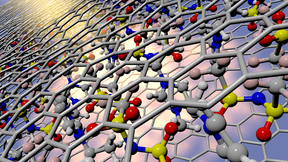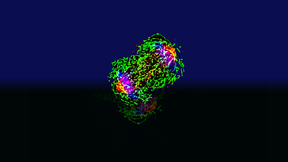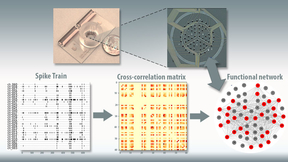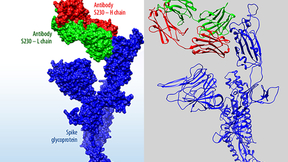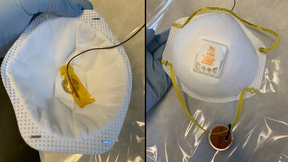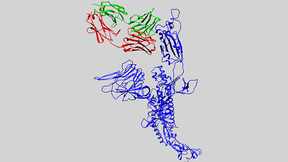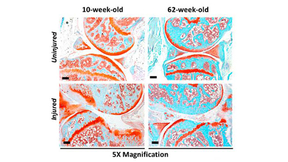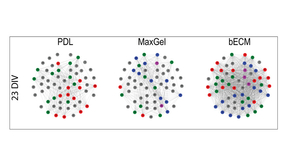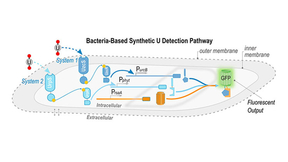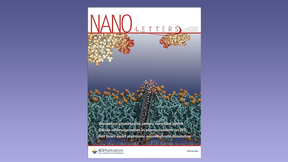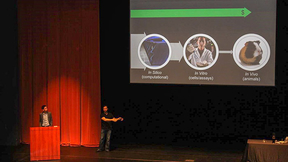Back
In addition to maintaining its Organization for the Prohibition of Chemical Weapons (OPCW) laboratory designation for analyzing suspect environmental samples, LLNL also is an OPCW-designated laboratory for the analysis of biomedical samples. (See "Lab earns 'A' in OPCW test) In this instance, OPCW inspectors have the ability to collect biomedical samples for cases of…
Lawrence Livermore National Laboratory (LLNL) researchers have increased the complexity of neuronal cultures grown on microelectrode arrays, a key step toward more accurately reproducing the cellular composition of the human brain outside the body. As described in a recently published paper in Scientific Reports, an LLNL team led by biomedical scientist Heather Enright…
Room temperature ionic liquids (ILs), a special class of molten salts, promise far greater electrochemical performance compared to conventional aqueous solutions due to a suite of novel and tunable properties. Over the past two decades, ILs have been explored as a means of improving a range of different technologies, from energy storage and conversion to catalysis to…
Lawrence Livermore National Laboratory (LLNL) researchers, in collaboration with Pennsylvania State University (PSU) and Idaho National Laboratory (INL), have designed a new process, based on a naturally occurring protein, that could extract and purify rare earth elements (REE) from low-grade sources. It could offer a new avenue toward a more diversified and sustainable…
Metastasis accounts for approximately 90 percent of mortality in breast cancer patients. During the last few decades, there has been significant progress in understanding genetic, molecular and signaling mechanisms underpinning cancer cell migration. Biologists from Lawrence Livermore National Laboratory (LLNL) found another mechanism that affects the maintenance and…
For the past several years, Lawrence Livermore National Laboratory (LLNL) scientists and engineers have made significant progress in development of a three-dimensional “brain-on-a-chip” device capable of recording neural activity of human brain cell cultures grown outside the body. Now, LLNL researchers have a way to computationally model the activity and structures of…
To help accelerate discovery of therapeutic antibodies or antiviral drugs for SARS-CoV-2, the virus that causes COVID-19, Lawrence Livermore National Laboratory (LLNL) has launched a searchable data portal to share its COVID-19 research with scientists worldwide and the general public. The portal houses a wealth of data LLNL scientists have gathered from their ongoing…
Two Lawrence Livermore National Laboratory (LLNL) researchers who have worked for more than eight years to develop a tularemia vaccine are part of a three-institution team that has been funded to bring their candidate to readiness for use. The two biomedical scientists, Nick Fischer and Amy Rasley, will collaborate with scientists from the University of New Mexico and the…
Lawrence Livermore National Laboratory (LLNL) researchers are studying ways to safely and rapidly remove viral threats from N95 respirators, without compromising the device’s fit and its ability to filter airborne particles, so they can be reused. As seen during the COVID-19 pandemic, a shortage of personal protective equipment, including surgical masks and respirators,…
Recent events such as the COVID-19 pandemic and the use of chemical weapons in the Syria conflict have provided a stark reminder of the plethora of chemical and biological threats that soldiers, medical personnel and first responders face during routine and emergency operations. Personnel safety relies on protective equipment which, unfortunately, still leaves much to be…
Gaby Loots and Aimy Sebastian (both BBTD) are embarking on a new five-year research project to identify ways to prevent post-traumatic osteoarthritis (OA) in knees and other joints as part of a $2.3 million grant awarded to UC Davis by the National Institutes of Health. Previous research shows that OA, or the breakdown of cartilage and other joint tissues, can be triggered…
Lawrence Livermore National Laboratory (LLNL) researchers have identified an initial set of therapeutic antibody sequences, designed in a few weeks using machine learning and supercomputing, aimed at binding and neutralizing SARS-CoV-2, the virus that causes COVID-19. The research team is performing experimental testing on the chosen antibody designs. Currently, treating…
Lawrence Livermore National Laboratory (LLNL) scientists are contributing to the global fight against COVID-19 by combining artificial intelligence/machine learning, bioinformatics and supercomputing to help discover candidates for new antibodies and pharmaceutical drugs to combat the disease. See the visualization Backed by five high performance computing (HPC) clusters…
Aging and injury are two major risk factors for osteoarthritis (OA), yet very little is known about how aging and injury interact and contribute to OA disease development. In a new study, researchers from LLNL, UC Merced, and UC Davis Medical Center examined age- and injury-related molecular changes in mouse knee joints that could contribute to OA. Using RNA sequencing,…
Former Secretary of Energy Rick Perry recognized Lawrence Livermore National Laboratory (LLNL) staff with six Secretary’s Honor Awards at a ceremony at Department of Energy (DOE) headquarters. The Secretary’s Honor Awards are bestowed on teams that have achieved a singular accomplishment that demonstrates a high level of performance and dedication to public service. As his…
DARPA’s Measuring Biological Aptitude (MBA) program begins and ends with the men and women of the United States military. The program — first announced in January 2019 — centers on how service members can access the potential of their own biological systems to achieve peak results across a range of military specializations, and aims for a detailed understanding of how…
In vitro organ-on-a-chip experimental platforms hold great promise to predict human biology and human-relevant responses to chemical and biological stimuli. LLNL scientists and engineers are working to more faithfully recapitulate the brain microenvironment on multi-electrode arrays to study brain activity. In an article recently published in Scientific Reports, Livermore…
The ability to detect uranium (U) through environmental monitoring is of critical importance for informing water resource protection and nonproliferation efforts. While technologies exist for environmental U detection, wide-area environmental monitoring—sampling coverage over large areas not known to possess U contamination—remains a challenging prospect that necessitates…
Biological signaling mechanisms often involve small molecules, ions, and protons, and facile in situ monitoring of the levels of these species is vital for medical diagnostics. Even the simplest signals, such as intracellular pH level, can provide important information. Of all biosensing platforms, electrical sensors represent the best opportunity to develop implantable…
LLNL scientists Nick Be (left) and Tim Carpenter describe the computational (in silico) methods and experimental (in vitro and in vivo) techniques used to speed up the therapeutic drug optimization process. The combination of these methods creates a pipeline to help scientists test more therapeutics at a lower cost. (Photo by Joanna Albala/LLNL Science Education Program.)…



